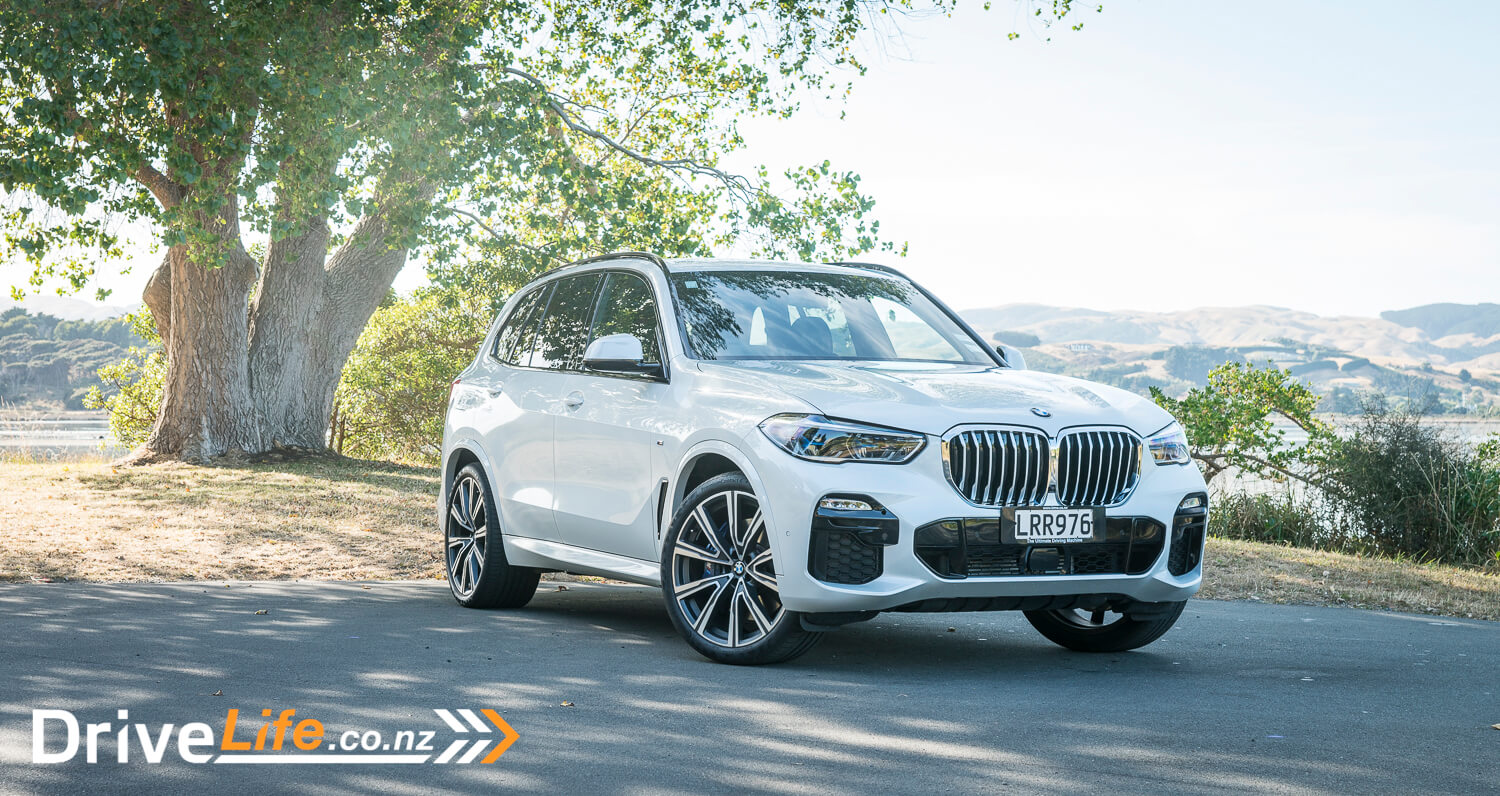The Big Daddy of the X range of BMWs, the X5 has undergone a facelift for 2019, and has received some more tech.
The X5 has been a great seller for BMW New Zealand. With half of X5 sales the base X30d model, happily this is the one BMW sent us to review. After having just got out of the all-new Audi Q8, can the X5 continue to keep buyers happy, and away from other brands?
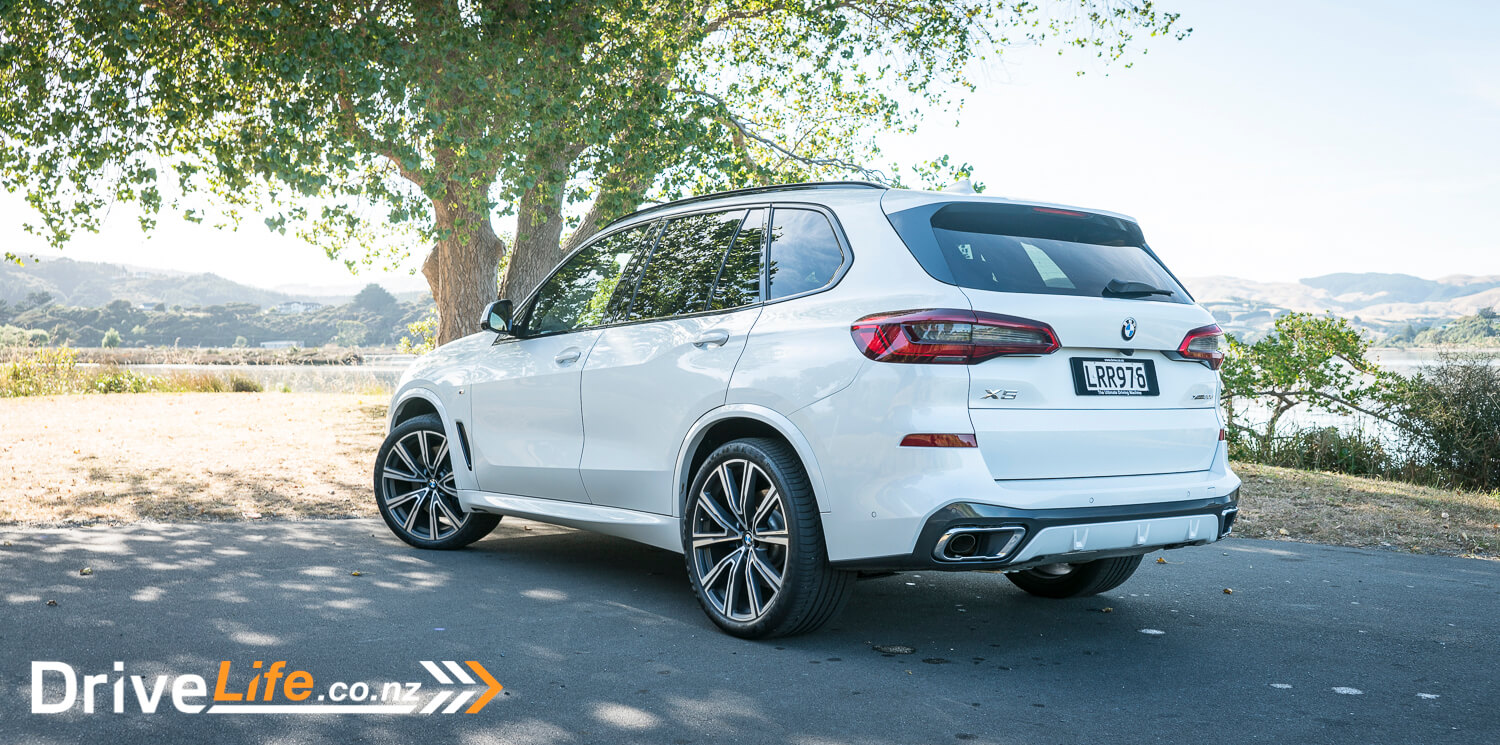
What’s In The 2019 BMW X5 Range?
You get to pick from three models of X5; the base model xDrive30d (which we tested), the xDrive40i M Sport, and the M50d.
There’s a base price of $135,200 plus on-road costs for the 30d. Our test car was up-specced with the M Sport package ($5,500), 22-inch BMW Individual alloy wheels ($3,000), Glass Crafted Clarity elements ($1,000), a trailer tow hitch ($2,400), metallic paint ($1,190), Comfort Package which includes heated front/rear seats & heated front armrests, sun protection glazing, acoustic front/side glass ($1,900), BMW LaserLights ($2,500), to bring the as-tested price up to $152,690.
The 40i has a base price of $147,900, and the M50d starts at $177,900.

The base model has a 3.0-litre, straight-six turbo-diesel motor, putting out a good 195kW of power and an excellent 620Nm of torque, getting you to 100km/h in 6.5 seconds.
If you buy the 40i M Sport, your powertrain changes to a 3.0-litre, straight-six, twin-scroll turbo petrol engine, with a meaty 250kW of power but a drop in torque to 450Nm. Your 0-100 time is now 5.5 seconds.
At the top of the tree is the stump-pulling M50d. This beast runs the same 3.0-litre diesel engine, but is fitted with no less than four turbochargers. This means you have 294 kilowatts of power, and an amazing 760Nm of torque. Your 0-100 time? 5.2 seconds. The four turbos are a mix of two for high pressure, and two for low pressure.
Standard equipment levels are high, as you’d expect with a starting price knocking on the door of $135K. This means permanent four-wheel drive, dynamic damper control, auto start/stop, brake energy recuperation, hill descent control, keyless entry and start, 20” alloy wheels, adaptive LED headlights, high beam assist, LED front fog lights, LED rear taillights, ambient interior lighting with 6 colours, Welcome Light Carpet and Dynamic Contour Lighting, auto wipers, auto headlights, heads-up display, rear cross traffic alert, steering and lane control assistant, lane keep assist, crossroads warning, evasion aid, automatic parking, parking sonar front and rear, Reversing Assistant, 360 degree camera view system, run flat tyres, BMW Live Cockpit with a 12.3” display, BMW Gesture Control, adaptive cruise control with stop/go, rear door sun blinds, heated front seats, leather upholstery, heated/cooled cup holders, digital radio tuning, wireless phone charging, hifi loudspeaker system, BMW Connected + system with Concierge Services, Connected Drive, Intelligent Emergency Call, Real Time Traffic Information, Remote Services and TeleServices.

I needed a break in my typing – there’s more. You also get 2 zone AC, automatic tailgate operation (including the lower tailgate), both front seats with electric adjustment including headrests, luggage compartment separating net, and a sports leather steering wheel.
Moving to the 40i M Sport, this adds 21” alloys, BMW LaserLights, M Sport brakes, M Sport steering wheel, M Sport package, M Sport exhaust system, and Adaptive M suspension.
Of course, there’s still the M50d. On top of the above, it changes to 22” alloys, Adaptive M Sport Suspension Professional, 4-zone AC, BMW Display Key, the Crafted Clarity Glass package, Heat Comfort package (front), Integral Active Steering, a Harmon/Kardon sound system, M Sport Differential, a panoramic glass sunroof, and lastly soft-close function for all doors.
All X5s are fitted with an 8-speed sport automatic gearbox.
There are literally pages of options for this car – to see more, check out BMW New Zealand’s website.

First Impressions Of The 2019 BMW X5 xDrive 30d
This is a big car – it looks even bigger than the Q8, especially since the rear of the car hasn’t been changed to a trendier fastback look.
The grille is the first thing that catches most people’s eye. It’s been increased in size, and now is almost a galvanising feature – it seems either you like it, or you hate it. That was the feedback I got from people who saw the car, anyway. It was a bit weird for me – I started off almost gagging at the sight of it, but after a week? I liked it a (little) bit more.

The X5 sure grabbed a lot more attention than I ever thought it would. Letting a bunch of teenagers cross on a pedestrian crossing got me thumbs up at the car, and at other times too I saw people looking. Maybe they were looking at the grille, I’m not sure, but it sure got some looks.
The rear of the car isn’t my most favourite part – the taillights look different than the previous model, but it’s all a bit subdued at the rear – it could almost be the rear end of a Korean brand of SUV, although the fake exhaust tips add a touch of sportiness.
The split tailgate is retained for this model of X5, and that’s great news for those who make the most of this feature.

What’s The Inside Like On A 2019 BMW X5 xDrive 30d?
Climbing up into the X5 was very much a different experience than the Q8 – this is a car you sit on, rather than in. It’s a commanding view out the windscreen, and looking back there’s masses of headroom, even for tall people.
Unfortunately, our test car had an all-black interior, with no sunroof of any sort so was a pretty dark place to be. Thankfully the huge front and side windows let this up a little.
Our test car was optioned with the $1,000 Glass Crafted Clarity elements package; this means a glass cover for the iDrive knob, the volume knob, the engine start/stop knob, and most obvious of all, the gear selector was mostly glass, with a big “X” inside it. I believe this will be a personal choice and perhaps aimed at a certain group of buyers, but it didn’t do it for me. The glass gear selector looked a bit naff, and did not feel good in your hand with lots of sharp edges and angles.

Speaking of BMW’s excellent iDrive system, this has been upgraded and is mostly better in its function, although the actual iDrive knob seems to have shifted back a bit, making it feel less natural to use.
There’s a new central display, looking much more integrated than the previous model, and lots bigger at 12.3”. The clarity is there too – it’s a brilliant update to the car.
Below the central display, are the AC controls – so simple, spreading across the dash. Below these are the audio controls, again nicely laid out in a line. You can of course use the steering wheel controls or iDrive or the touchscreen to operate the audio, but sometimes it’s just easier to push a button. Good to see that BMW still have an actual volume knob, although it’s a long stretch away for the driver. Probably the driver is expected to use the steering wheel controls and the knob is for the passenger.

There’s a front cubby with heated/cooled drink holders (that turn blue or red when used), and there’s also the Qi wireless phone charging pad up there. The pad itself is tilted up at a good angle, so no danger with your phone sliding about (and then stopping charging) as we’ve seen with some cars.
Also in the front cubby is a single, standard USB port, as well as a 12-volt socket, and there’s another small cubby to the right hand side of the steering wheel.
Behind the gear selector is another good-sized and illuminated cubby, this one with a single USB-C port. I understand BMW’s reasoning to move to USB-C, but there’s no standard USB port in here – just the new C-type. I don’t have any devices that can charge off USB-C without an adapter.
The interior overall is a good move forward from previous model, it looks as luxurious as you’d expect, and it was fantastic to see that almost every surface you can touch from the driver’s seat is soft-touch – even the bottom of the doors are soft-touch.
Not soft touch but feeling very nice are the solid alloy interior door handles – they look great, and feel great too. One of those things that makes a difference. Everything on the inside feels expensive and reeks of quality.
That is, except for a couple of things. There’s checked alloy panels used on the doors, dash and centre console. I think they are supposed to look a bit like carbon fibre, but they don’t. This was my least favourite part of the interior – the checked design seemed to pull my eyes in to it. I didn’t quite go cross-eyed, but I sure avoided looking at those alloy panels after that. Some people liked the finish, but they were in the minority. This would be something I’d be changing before purchase. Call me old school, but this is a time a nice bit of wood would look so much better, but that’s just me.

One last elephant in the room; we’ve got to talk about that speaker grille, up high and centre on the top of the dash. We have all these luxurious materials used throughout the cabin, then a hard plastic speaker grille right up where your eyes fall. It even feels cheap, and sounds cheap with a hard-plastic sound to it. It looks so out of place.
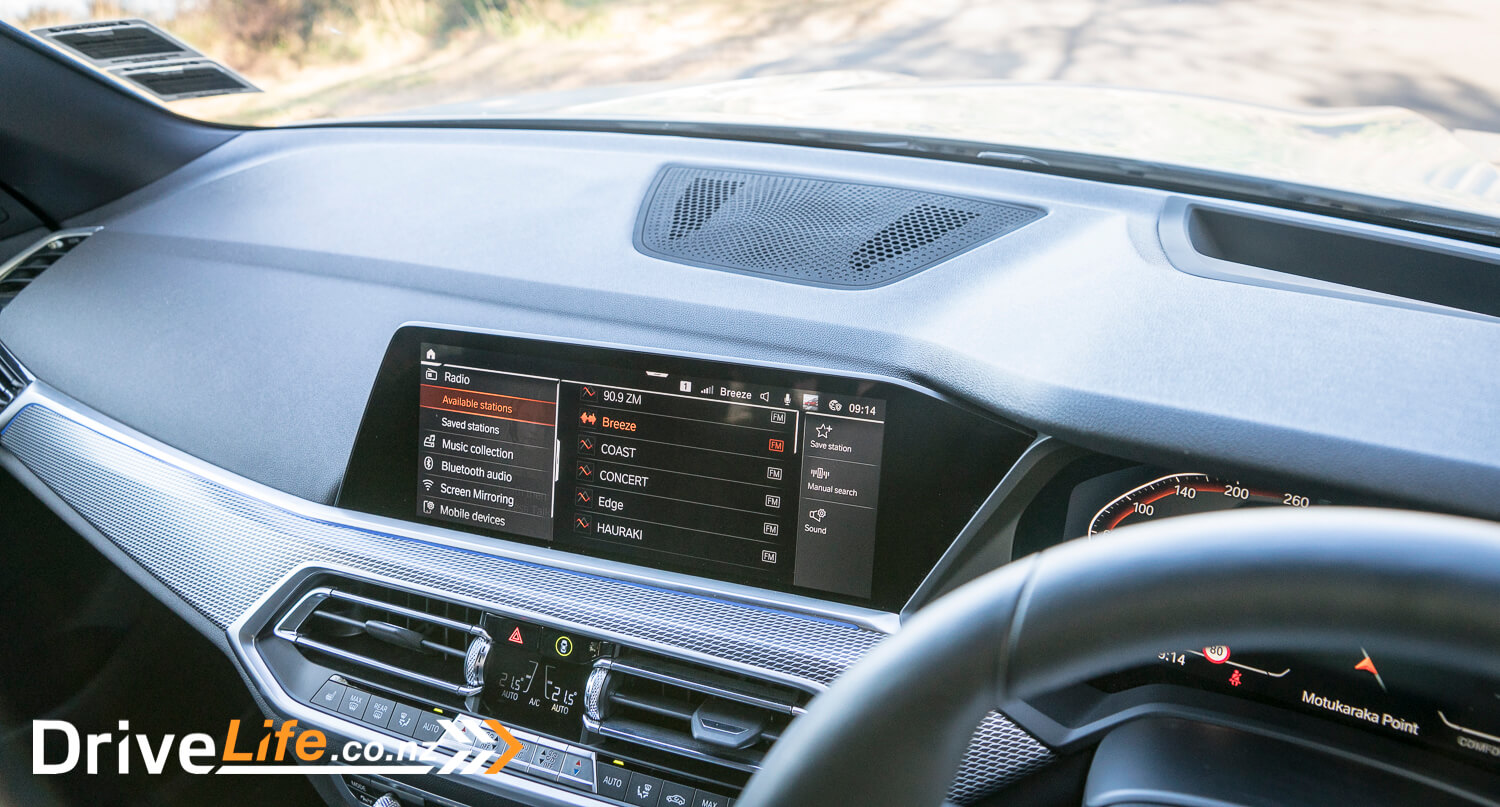
A heated steering wheel is standard, and it was good to see the physical button for this right there in the lower-centre of the steering wheel, instead of having to hunt through a menu system on the centre display.
Rear-seat passengers certainly aren’t hard done by when it comes to legroom. It’s not quite up there with the Q8, but there’s still plenty of it. In other respects, the rear is not as luxurious as the front; there’s no display of any sort like the Q8 has, there’s no controls for the rear AC at all.
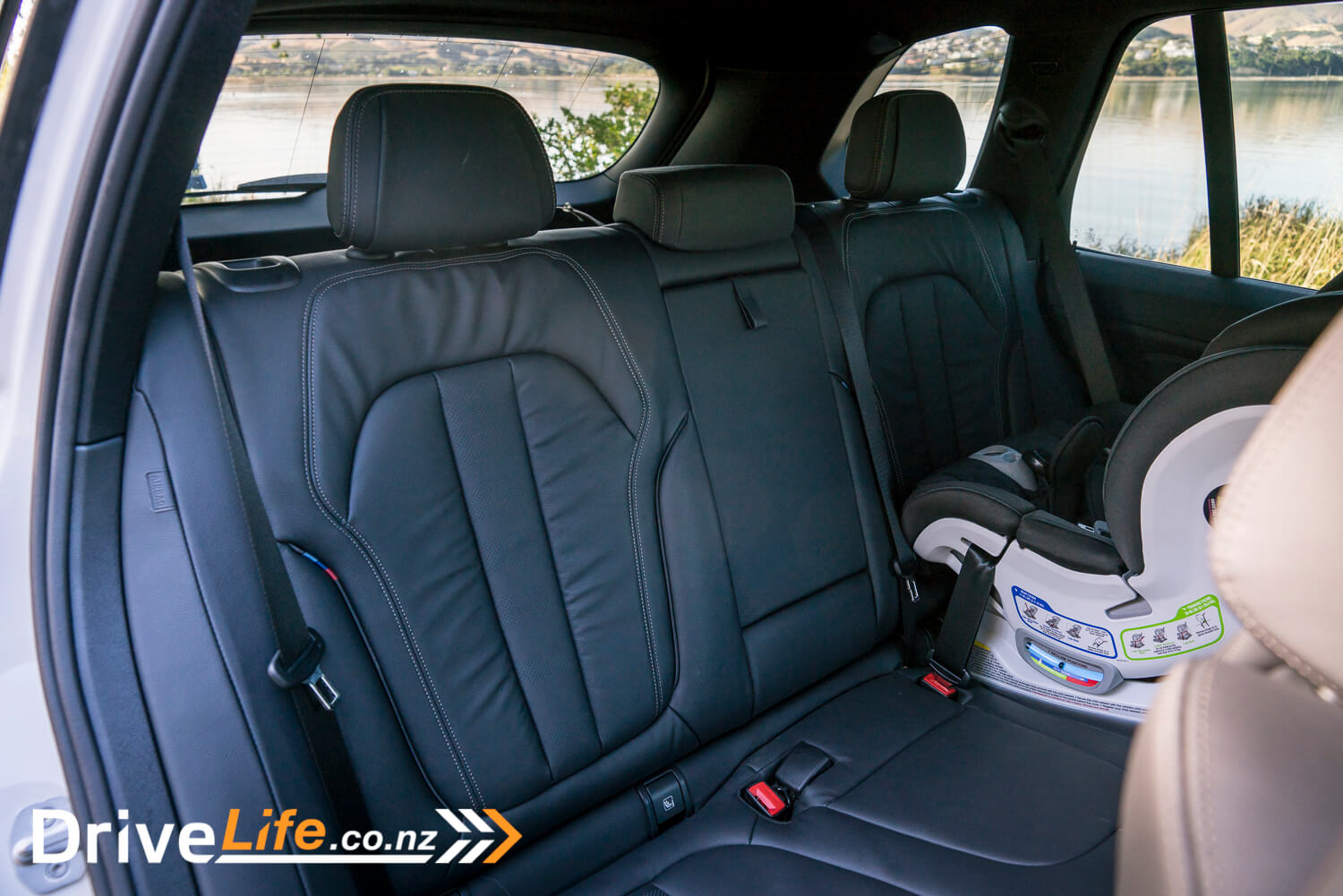
There are two small cubbies below the air vents (where I assume a digital display could go) and a single 12-volt socket down by the floor.
Then there’s the back of the front seats. These are fitted with one slot each, where you can purchase a mount system for a tablet, which seems like an excellent idea. Next to the mounting holes is a single USB-C port. This would be great for a tablet with a USB-C port for charging, but an iPad isn’t going to charge off this without some sort of adaptor. There’s no other USB ports for the rear passengers.
There are massive door cubbies for the rear passengers though, and seat comfort is right up there. This new X5 is the brand’s first car to have the ability to unlock it using Near Field Communication (NFC), which means your smartphone can unlock your car for you.
Our test X5 was a 5-seater, however there is a 7-seat option. For the previous generation of X5s, 80% were sold as 7-seaters.
A bit of a shame that the rear seats don’t slide at all to give you more legroom or more storage. Not the end of the world though, as rear cargo room is good at 645 litres, and there’s a space-saver spare under the floor – one up from only getting a pump. It’s nice to see a gas strut holds up the false floor for you.
The parcel tray cover can stow under the floor too, which is always appreciated, and there’s also a fabric screen stowed down there for your use. An electric parcel tray cover is an option.

What Does The 2019 BMW X5 xDrive 30d Drive Like?
First up, hit the glass-covered start button, and that 3-litre, twin-scroll turbo-diesel comes to life. Who doesn’t love a straight six, BMW diesel engine? It’s as good as ever, and sounds fantastic – often not sounding like a diesel at all. I’m not sure if there’s some trickery going on with fake engine sounds, but at certain times this engine growls like an old-school straight-six BMW petrol engine.
It pulls too, with that 620Nm of torque – a prod of the gas pedal will see you shooting forward. Then you put Sport mode on, and it’s even more responsive, throwing you into the back of the seat on full acceleration. With many brands moving to V6 diesels, it was great to drive a straight six again, and wonder what all the fuss is about.
Talking about engine start up, one thing I was very impressed with was the infotainment system. Start the car, and it’s on. There’s no waiting for it to boot up (some cars are horrendously slow at this). Nope, it’s on almost instantly. Big ups to BMW for getting this sorted.
Our test car was optioned with 22” rims (over the standard 20”), 30 profile tyres. I’m going to compare it to the Q8 again; the Q8 has air suspension and 22” rims, and rides bloody well. No, the X5 doesn’t ride as well, but it rides far better than it should.

I spoke earlier about the car feeling big, and driving it doesn’t change that much. It’s W-I-D-E at over 2 metres, and feels it. I got used to it, sure, but it was always present in my mind. So tall too, which you would think would make it handle like jelly.
But that’s not so. I took the X5 on a twisty, quiet road one night, left it in Comfort mode, and then tested it out for handling. It did extremely well, some body roll but overall fantastic grip – as you’d expect with AWD and those huge 315 rear tyres.
At a few points, the back of the car stepped out on a bumpy corner at speed – and it was still all under control. The X5’s grip is phenomenal.
Then I did the same road, but in Sport mode. This almost transformed the car – steering was sharper and felt better, body roll less pronounced, and everything felt good. And dare I say it, so good it felt like fun. This was in a car weighing in at over 2,100Kg. It shouldn’t be fun and it shouldn’t handle as well as this.
Another option of our test car was the Laserlight package, at $2,500. That’s a fair cost to pay over standard headlights – and let’s get one thing straight, there’s nothing wrong with BMW’s standard headlights. According to the material from BMW, the Laserlights can project light up to 600m away, and use GPS to anticipate what’s coming up ahead (e.g. a bend in the road) and then adapt the headlights to suit.
They also have the ability to spotlight animals and pedestrians up to 100 metres away. Laserlight is equipped with an infrared camera that illuminates these obstacles.

So, did they work? Are they worth the extra expense? A partial yes, from me. Yup, they are definitely better than standard headlights, the beams penetrate a long way ahead, and you can see the quality of the light is brighter. The GPS system seemed to work well, and it changed the headlights when approaching a corner. But I think I’d need to test it out on rural roads to be a convert, where there’s no other light to help them. I believe this is where Laserlights would really shine.
The X5’s steering wheel feels fatter than before, and still nice with a great feel to it. There’s the obligatory M Sport badge on it of course, and the steering wheel controls have been changed slightly – in some ways better, in others not so much. Using the thumbwheel on the right hand side to change audio tracks or stations is great, tracks just pop up on the HUD – select your track and push the thumbwheel in. Excellent. But I always struggled with the volume controls – they feel awkwardly placed, and in the wrong direction. For me, volume buttons on a steering wheel should always be upper and lower buttons – logical. On the X5, they are side by side, and I felt myself looking down to them too often.
Still on the steering wheel, this new model has lights above the groups of buttons on both sides. Getting too close to an obstacle? The lights will flash orange, and then red if you are in the ‘oh shit’ distance. They are used quite a bit, but only really come into their own at night time – they’re just a little too dull to make a difference in daylight, and not really in your line of sight, especially compared to the HUD or even the dashboard.

Standard equipment on the X5 includes Steering Assist, that – when adaptive cruise control is on – will help guide the car through corners and keep you in your lane. You can turn this off anytime you want to by hitting the Mode button on the steering wheel. Steering Assist in the X5 is quite aggressive, and I could see it putting some people off, but I used it almost extensively.
A handy safety aspect of this feature is if say you fall asleep, or worse (think cardiac arrest). If your hands fall from the steering wheel, you have around ten seconds until an orange warning light will appear on the HUD and also the dash – the steering wheel will light up orange too – to tell you to put your hands back on the wheel (it will continue to assist in steering, though). If you don’t, after another ten seconds the lights will turn red, then if you still haven’t taken the wheel, the car will gently (but quite quickly) slow down, then stop, and turn the hazard flashers on. I tested this and it was flawless.
Things like this are all the features of electric power steering coming into their own. Another feature that uses the electric power steering extensively is Reversing Assistant. Let’s say you are driving around an almost chicane of a car park, and get to the end and need to reverse out – and you aren’t a confident reverser. Simply turn on Reversing Assistant, and the car will take you back exactly the same way you can, reversing your steering inputs. This works up to 50 metres max, and you still have to operate the brake, but I can see some people really liking this feature. It’s a great party trick, too.
Speaking of the HUD, this has some changes too. It’s a bit of a mixed bag for me, the X5’s HUD. On the plus side of things, when using SatNav, three quarters of the HUD (and it’s huge) turn into a map of the streets you are on, complete with street names and your path with the normal arrows to show you where and when to turn. On the motorway, we’re used to seeing a picture come up on the central display to show you what lane you should be in, and the X5 does this, but it replicates this on the HUD. And I’m not talking a couple of small arrows – it’s a big ass graphic of the lanes, showing you where you should be. Brilliant.
On the ‘but’ side of the HUD, you can’t customise it too much. You can tell the car to switch the HUD to a Sports mode if the car gets placed into Sports mode, but all this does is give you a bar-style rev counter in the HUD. What I really wanted (and expected) was a gear indicator as well, so I can see exactly what gear I’m in while driving in Sports mode. I think I was bit spoiled recently with the AMG C43, and its seven HUD modes.
Talking about a lack of customisation, the dashboard too is not very customisable. You can have the satnav map in between the speedo and rev counter, and that’s pretty much it. Again, I was spoiled with the huge range of adjustments on my last two test cars – the AMG C43 and then the Audi Q8, which both offer a huge range of dashboard settings. Again, not the end of the world but surprising to see.

Assisted Drive is in place, and new to this is the ability to change your cruise control speed to the current limit with one press of the button. Let’s say you’re driving along using adaptive cruise, and then the speed limit changes to 70km/h. Simply press the ‘set’ button on the steering wheel, and your cruise control speed will change to the new limit. A simpler and easier way to control your speed.
For this new model, BMW have entered the voice-controlled foray, with a ‘Hey BMW’ system similar to other manufacturers. It’s really no different than Mercedes-Benz or Volvo, and just as handy. Simply say, “Hey BMW” and then when it responds, something like, “It’s too cold” and she’ll ask you what temperature you want the car set to. You can also command the audio like this, and SatNav. Is it handy? Sure. Could I live without it? For sure. For some people though they’d take to it like a duck to water, and avoid using the steering wheel, AC controls or touchscreen to do anything, and use voice commands instead.
Speaking of commands, I tried so hard to use the gesture controls that BMW has had for some time. I still couldn’t master it, though. I got better, but the ‘Harry Potter without his wand’ scenario was at work lots of times. It seemed I could wave my fingers around to reduce the volume one time, and then not the next. I’ll stick to buttons, but I know some people who have mastered this.

The day to day drive in the X5 is a breeze, even if it is big. You’ve got those huge side windows, a big windscreen and the sheer height of the car helps here too. There’s also relatively big exterior mirrors, blind spot monitoring of course, and sliding sun visors are always a welcome feature for me. One slight negative here; the A pillars are massively thick, and can block your vision.
Naturally you get a 360-degree camera system, this has a multitude of views, including Tow Hitch view (handy!), car wash view, and 360 view. In 360 view you can click through the different camera angles and also use your fingers to flick the car around to check out your surroundings.
Getting too close to that concrete wall? The cameras will automatically switch to the closest obstacle, and then give you a bird’s eye view so you can see exactly how close you are. I’m going to miss having this feature when I give the car back
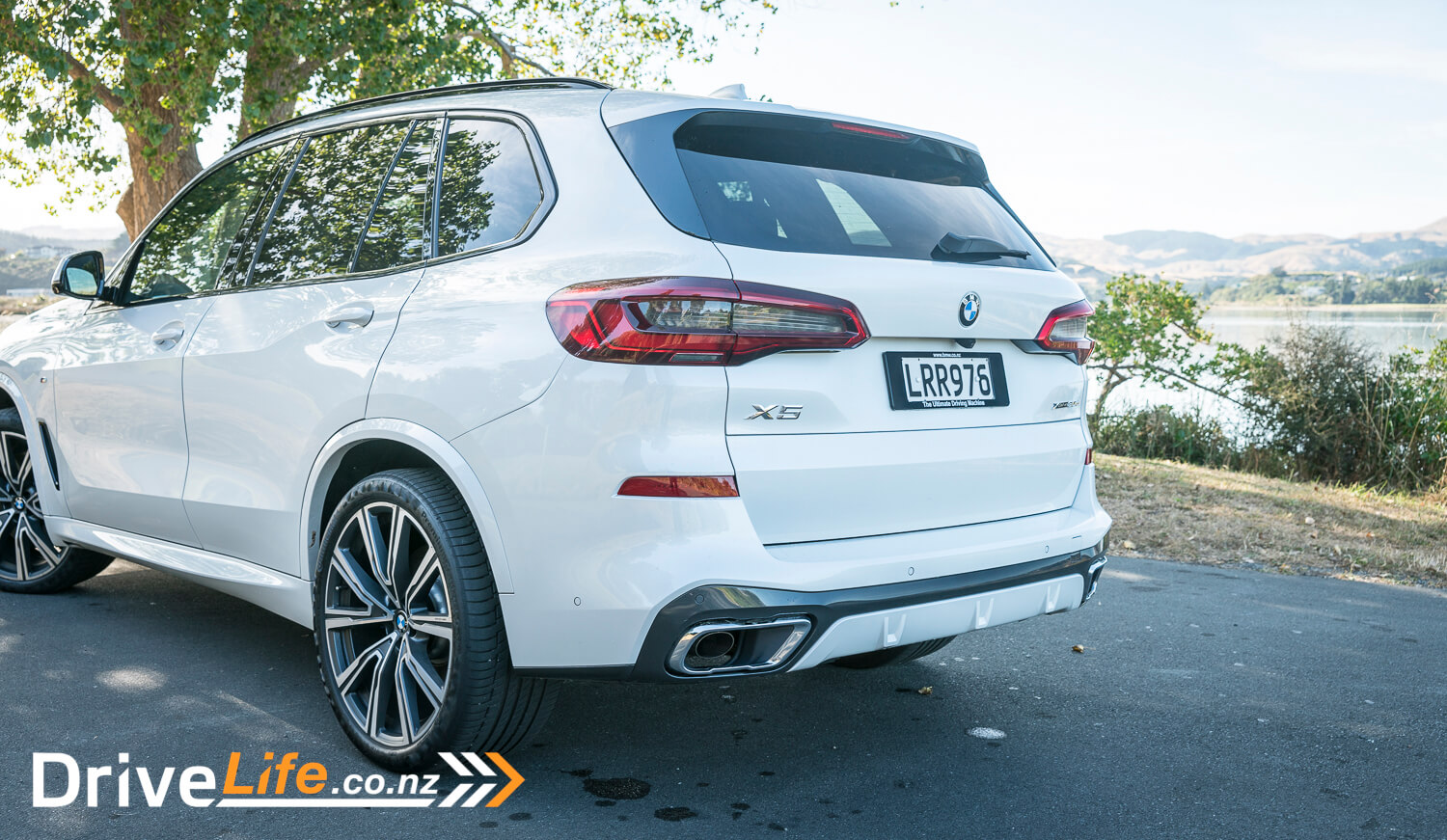
Our test car was fitted with an electric tow bar option, and certainly this saves your knees from getting smashed by a tow ball. The switch to control this is in the cargo area, and I love the that wiring for the trailer light is integrated into the tow hitch itself – nice and tidy. In saying that, the plug is a round (euro) one so you are going to need an adaptor.
When I picked up the X5, it had a full tank of diesel and 1,000km of range. Nice. We ended up keeping the car for three weeks, swapping it between three drivers, so it got a workout over a range of driving behaviours. In total, the test car covered 700km and gave us 9.1L/100km. BMW claims 6.8 L/100km.

What’s The Competition For The 2019 BMW X5 xDrive 30d?
| Brand/Model | Engine | Power/ Torque kW/Nm |
Towing capacity, unbraked/braked (Kg) |
Seats | Cargo capacity, litres | Fuel L/100km | Price | |
| Range Rover TDV6 Vogue | 3-litre, turbo V6 diesel | 190/600 | NA/3500 | 5 | 900 | 6.9 | $181,900 | |
| Lexus LX450D | 4.5-litre, twin-turbo V8 diesel | 200/650 | 750/3500 | 5 | NA | 9.5 | $160,100 | |
| Audi Q8 | 3-litre, twin-turbo, V6 diesel | 210/600 | 750/3500 | 5 | 605 | 6.8 | $149,900 | |
| Mercedes-Benz GLS350d | 3-litre turbo V6 diesel | 190/620 | NA/NA | 7 | 680 | 7.6 | $141,800 | |
| BMW X5 x30d | 3-litre, twin-scroll turbo, straight 6 diesel | 195/620 | 750/2700 | 5 (7 opt.) | 645 | 6.8 |
|

What’s The Pros And Cons For The 2019 BMW X5 xDrive 30d?
| Pros | Cons |
|
|
What’s The Verdict For The 2019 BMW X5 xDrive 30d?
Yes, I had a few minor niggles with the latest X5. But here’s the thing – whether you are driving it or riding in the X5, BMW has nailed it. It’s a joy to drive; the engine is a gem, the transmission perfect and the handling surprising for such a large SUV.
Overall, it’s a good improvement over the previous model, and that motor is something I hope they never change.
The 2019 BMW X5 is very close to a 5-Chevron rating, but not quite there (yet).

2019 BMW X5 rating: 4.5 Chevrons
2019 BMW X5 xDrive 30d – Specifications
| Vehicle Type | Large, 5-door AWD SUV |
| Starting Price | $135,200 |
| Price as Tested | $152,690 |
| Engine | 3-litre straight six, twin-turbo diesel |
| Transmission | 8-speed automatic |
| Power, Torque | 195kW/620Nm |
| 0-100km/h, seconds | 6.5 |
| Spare Wheel | Space saver |
| Kerb Weight, Kg | 2,110 |
| Length x Width x Height, mm | 4922x2004x1745 |
| Cargo Capacity, litres | 645/1860 |
| Fuel Economy, L/100km | Advertised Spec – combined – 6.8 Real World Test – combined – 9.1 Low Usage: 0-6 / Medium Usage 6-12 / High Usage 12+ |
| Fuel tank capacity, litres | 80 |
| Towing Capacity Kg, unbraked/braked |
750/2700 |
| Turning circle, metres | 12.6 Small: 6-10m / Medium 10-12m / Large 12m+ |
| Warranty | Five-year warranty Three-year service inclusive programme Five-year roadside assist |
| ANCAP Safety Ratings | 5 Star |





